Since the first Community Health Center (CHC) opened in 1965, our nation’s largest primary care network has expanded to over 1,500 sites, now serving more than 32.5 million people across the United States and its territories—in both rural and urban communities. Despite their growth and critical role in healthcare delivery, several misconceptions about CHCs persist, particularly around who they serve and how they serve our nation’s complex healthcare needs.
CHCs are nonprofit, community-based organizations governed by and for patients within the community, providing primary and preventive healthcare to all those in need, operating under comprehensive federal guidelines and located in medically underserved areas. They provide care to all individuals, regardless of insurance status or ability to pay. Offering a wide range of services—including medical, dental, behavioral health care, and access to discounted prescription medications—CHCs are a vital part of the health care safety net. They are often among the largest employers in their communities, and their board, staff, and leadership are often members of the community, giving them a unique perspective and the special privilege of being truly of and for the communities they serve.
In the following true/false list, we’re breaking down common myths and sharing the facts to help clarify the essential role CHCs play in our healthcare system.
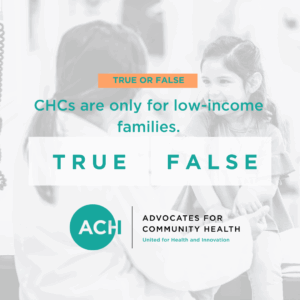
1. Myth: CHCs are only for low-income individuals and families.
Fact: False.
By law, CHCs must be located in federally designated medically underserved areas (MUAs)—ensuring that care reaches communities with the greatest need. Despite this targeted focus, CHCs are open to everyone, including children, regardless of income or insurance status.
Whether you’re insured, underinsured, or uninsured, CHCs provide accessible, high-quality care to all who walk through their doors. Health centers exist to care for everyone in need.
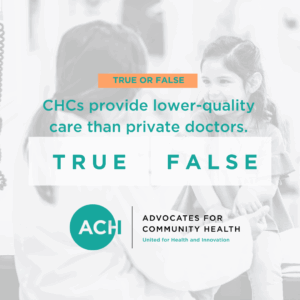
2. Myth: CHCs provide lower-quality care than private/other doctors.
Fact: False.
Studies show that the quality of care at CHCs is equal to or better than that of private practices/providers, especially in managing chronic diseases and preventive care. Research consistently finds that CHCs excel in managing diabetes, hypertension, and asthma. For example, patients at CHCs are more likely to receive recommended screenings, have their blood sugar and blood pressure controlled effectively, and follow through with treatment plans.
CHCs also typically achieve higher rates of preventive services, such as vaccinations, cancer screenings (breast, cervical, colorectal), and well-child visits. These services help detect problems early and prevent complications.
Multiple studies also show that patients often have comparable or better outcomes on measures like hospital admissions and emergency department visits compared to patients seen in private practices, and surveys have also shown high rates of patient satisfaction.
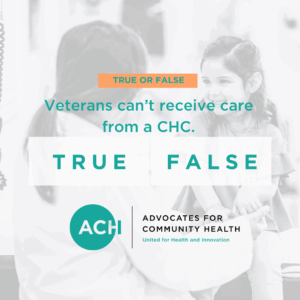
3. Myth: Veterans can’t receive care from a CHC.
Fact: False.
CHCs care for about 400,000 veterans each year. Under the Community Care program, veterans can receive care at a CHC if the Department of Veterans Affairs (VA) makes them wait more than 20 days for a visit, or if the drive to the VA office is more than 30 minutes away. From telehealth services through VA pilot programs to mental health care, oral health, and housing support, CHCs proudly serve veterans and are committed to meeting their comprehensive health and social needs.
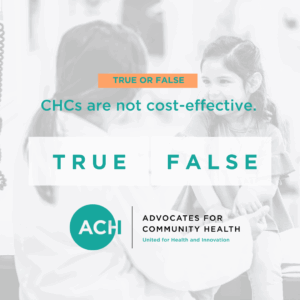
4. Myth: CHCs are not cost-effective.
Fact: False
CHCs are widely recognized for providing comprehensive, coordinated care that focuses on the whole patient. Many CHCs offer a wide range of services—medical, dental, behavioral health, pharmacy and more—all under one roof, creating a convenient, one-stop, cost-effective model for patients.
One major advantage of CHCs is their ability to reduce prescription drug costs through the federal 340B Drug Pricing Program. By purchasing medications at a discounted price, CHCs can offer discounted medications to patients, and generate critical revenue to support their services and create even more access to vitally needed services in the community.
Research consistently shows that the quality of care provided by CHCs meets—or often exceeds—that of private practices. At the same time, the integrated services available at CHCs remain significantly more affordable, especially for uninsured or underinsured patients.
Beyond healthcare, CHCs have a strong economic impact. They generate over $85 billion in economic output annually and support more than 500,000 jobs in the communities they serve.
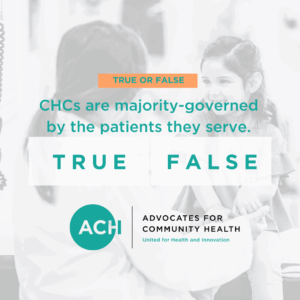
5. Myth: CHCs are majority-governed by the patients they serve.
Fact: True
CHCs are deeply committed to patient-centered care. A defining feature of CHCs is that at least 51% of their governing board members must be current patients of the clinic. This unique governance model – the consumer majority board – ensures that decision-making is informed by the lived experiences and needs of the community served. It fosters a high level of accountability and engagement, making CHCs one of the most participatory models in healthcare delivery.
By both mission and federal mandate, CHCs offer enabling services designed to help patients overcome barriers to care, including:
- Transportation assistance
- Language translation and interpretation
- Support for food security
- Help accessing additional social and community services

6. Myth: CHCs rely heavily on federal grants, Medicaid, and 340B to keep their doors open.
Fact: True
Yes, Community Health Centers (CHCs) do rely heavily on Medicaid and federal grants for their funding. The national average for health center margins is just 1-2%, here’s why their funding mix is so important:
- Medicaid: Because more than half of CHC patients rely on Medicaid for their health coverage, Medicaid is one of the largest sources of revenue for CHCs and can account for upwards of 70% of overall revenue. Many patients served by CHCs are low-income and qualify for Medicaid – in fact, 90% of health center patients are at or below 200% of federal poverty level. CHCs are paid through a per-visit rate, the Federally Qualified Health Center (FQHC) Prospective Payment System, which provides critically important predictability and helps cover the cost of care.
- Federal Grants: Federal support for CHCs is administered by the Health Resources and Services Administration (HRSA), primarily through Section 330 of the Public Health Service Act. These grants help with operating costs and help ensure CHCs can provide care regardless of a patient’s ability to pay.
- 340B: The 340B program is also an important way health centers serve their patients. By allowing the purchase of drugs at a discounted price, the 340B program enables CHCs to serve more patients, at a higher level of complexity, than they otherwise could. As required by law and regulation, and as core to their mission, CHCs reinvest every dollar of program income back into patient care, maximizing federal investment and expanding care to underserved communities effectively and efficiently.
While CHCs also receive revenue from private insurance, patient fees, and other sources, Medicaid, federal grants, and 340B together make up the majority of their support, enabling them to serve underserved populations effectively.
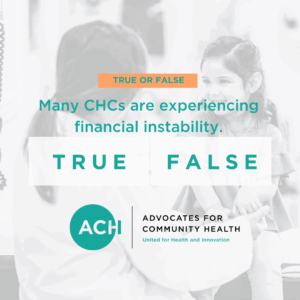
7. Myth: Many CHCs are experiencing financial instability, and some may have to close as a result.
Fact: True
The average financial margin for CHCs approaches a negative 2.2% while 42% of CHCs report having 90 days or less cash on hand, according to the National Association of Community Health Centers. Several factors are contributing to the financial instability of CHCs:
- Uncertain Federal Funding: The short-term extensions of the Community Health Center Fund over the past 18 months have left many centers without a stable financial foundation.
- Rising Operational Costs: Inflation and increased demand for services have outpaced revenue growth, leading to negative financial margins for many centers. Unlike other providers, health centers are not able to adjust their rates at will. Because of this, as the cost of goods, services, workforce and care has increased, health centers have not been able to keep pace with these increased costs to cover their true operating expenses.
- Medicaid Cuts & Medicaid Enrollment Declines: CHCs are bracing for forthcoming Medicaid cuts signed into law in July 2025, which are expected to result in 11.8M people losing Medicaid coverage and nearly $1 trillion being taken out of the Medicaid program.
Impact on Services
These financial challenges have led to:
- Staff Layoffs: Centers have reduced their workforce to cope with budget constraints, impacting service delivery.
- Service Reductions: Some CHCs have had to scale back or eliminate certain services due to lack of funding.
- Uncertainty for Patients: Patients face uncertainty about the continuity of care as centers navigate financial instability.
- Site Closures: Whether satellite sites, discontinued expansion plans, or in a worst case scenario, the closing of flagship facilities, some health centers have had to close points of access due to lack of resources to support operations.
- Workforce Strains: Between financial uncertainty and lack of resources, the ability of health centers to recruit and retain healthcare workforce, particularly clinicians, has been severely impacted due to financial constraints.
The overall financial outlook remains precarious. Advocacy for sustained and increased federal support is crucial to ensure the continued operation of CHCs and the health of the communities they serve.
In a healthcare landscape that is increasingly strained, Community Health Centers remain an essential source of high-quality, affordable health care for more than 32 million people across the U.S. As this blog shows, the myths that persist about CHCs often obscure the remarkable value they deliver—to patients, to communities, and to the broader health system. Now, more than ever, it’s vital to understand and support the mission of health centers. Whether it’s through federal investment, local advocacy, or simply sharing the facts, we all have a role to play in protecting and strengthening this lifeline of care. Because when CHCs thrive, communities thrive.